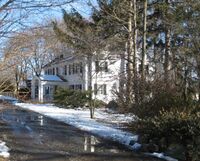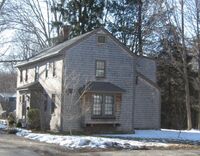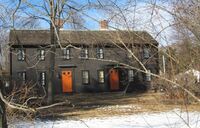Items
-
 Eaton-Prescott farm : 284 Summer Avenue 284 Summer Avenue : Eaton-Prescott Farm. Originally situated on a 100 plus acre farm stretching from Woburn to Oak and West Street to Washington Street, this house sheltered a long line of the locally prominent Eaton family. Homesteaded before 1700 by John Felch, the land was bought by Thomas Eaton, a tanner and farmer, in 1712. It is believed that the original Eaton house was built one and a half stories high with a gambrel roof. Multiple renovations transformed the original home into the traditional Georgian style home with Greek Revival influence that we see today. Thomas Eaton expanded his land holdings and eventually gave parcels to his children where they settled with their families. Joshua Eaton, Jr. grew up in one of these homesteads. On April 19th, 1775, twenty-year-old Joshua Eaton, Jr. (grandson of Thomas Eaton) marched to Concord and Lexington with Captain John Bacheller's Minutemen and was later killed at the storming of Saratoga in 1777. He was the only Reading soldier to die in action during the Revolution. In 1948 the town voted to build a new elementary school at the site of his childhood home. The Joshua Eaton Elementary School was dedicated October 23rd, 1949. The original Eaton house was passed down through the generations and was eventually inherited by Abigail Eaton (great-granddaughter of Thomas Eaton). In 1813, Abigail was married to Joshua Prescott, a lawyer and graduate of Harvard University. He was a civic leader and served as counsel for citizens seeking to establish the Andover-Medford Turnpike (now Main Street). He is also credited with doing much to bring the railroad through Reading when the intention was to run the first branch through Woburn. Beginning in 1845, streets were laid out over the original farmlands, dividing the original farm into house lots. Stonewalls were taken for foundation stones of new homes. The Eaton-Prescott estate was finally sold out of Prescott ownership in 1902 when local architect Willard Adden purchased and remodeled the house adding an extension, garage, and dormers. Since then, owners have used a rear, north door as the main entrance.
Eaton-Prescott farm : 284 Summer Avenue 284 Summer Avenue : Eaton-Prescott Farm. Originally situated on a 100 plus acre farm stretching from Woburn to Oak and West Street to Washington Street, this house sheltered a long line of the locally prominent Eaton family. Homesteaded before 1700 by John Felch, the land was bought by Thomas Eaton, a tanner and farmer, in 1712. It is believed that the original Eaton house was built one and a half stories high with a gambrel roof. Multiple renovations transformed the original home into the traditional Georgian style home with Greek Revival influence that we see today. Thomas Eaton expanded his land holdings and eventually gave parcels to his children where they settled with their families. Joshua Eaton, Jr. grew up in one of these homesteads. On April 19th, 1775, twenty-year-old Joshua Eaton, Jr. (grandson of Thomas Eaton) marched to Concord and Lexington with Captain John Bacheller's Minutemen and was later killed at the storming of Saratoga in 1777. He was the only Reading soldier to die in action during the Revolution. In 1948 the town voted to build a new elementary school at the site of his childhood home. The Joshua Eaton Elementary School was dedicated October 23rd, 1949. The original Eaton house was passed down through the generations and was eventually inherited by Abigail Eaton (great-granddaughter of Thomas Eaton). In 1813, Abigail was married to Joshua Prescott, a lawyer and graduate of Harvard University. He was a civic leader and served as counsel for citizens seeking to establish the Andover-Medford Turnpike (now Main Street). He is also credited with doing much to bring the railroad through Reading when the intention was to run the first branch through Woburn. Beginning in 1845, streets were laid out over the original farmlands, dividing the original farm into house lots. Stonewalls were taken for foundation stones of new homes. The Eaton-Prescott estate was finally sold out of Prescott ownership in 1902 when local architect Willard Adden purchased and remodeled the house adding an extension, garage, and dormers. Since then, owners have used a rear, north door as the main entrance. -
 Samuel Bancroft house : 232 West Street 232 West Street : Samuel Bancroft House. This property was part of a farm pieced together by Henry Merrow over the years between 1652 and 1681. The farm was well situated on fertile land between "two highways", which survive today as County Road and West Street. The home is a Georgian style of colonial dwelling, but with a modern bay window added on the east side and porch and portico on the south. Samuel Bancroft, Jr. purchased the land from Henry's grandson in 1748, and it is thought he may have enlarged part of Merrow's previous dwelling and located it near the road that led from Woburn to the meetinghouse and village now Woburn Street. Samuel Bancroft came from a prominent family, many of whom settled in Reading. He was captain of the Militia in 1757 for the relief of Fort William Henry on Lake George. He also served as a Reading Selectman and in the state Legislature. Historians think this home had a large end chimney when Samuel built it. Evidence that it was created from a previous dwelling comes from two sills beneath the dining room and kitchen, as well as several cut features in the beams that have no purpose in the current configuration. However, a number of the features were lost prior to 1921 when the Winchesters owned it. They were especially proud of the exposed beams in the dining room that are a fine example of early American building techniques. Samuel Bancroft, Jr. had eleven children. His son Edmund, born in the house in 1751, was a soldier in the American Revolution, serving at Lexington and Concord on April 19, 1775. Another son, Aaron, born in 1755, marched to Cambridge with a group of minutemen after the Battle of Bunker Hill. Aaron later graduated from Harvard, and became an ordained minister of the Unitarian Church in Worcester as well as an author of some fame whose book, "Life of Washington", went through several editions. The house left the Bancroft family in 1793 and passed to another well-known Reading resident, Ephraim Weston, in 1798. Ephraim was a major shoe manufacturer, wholesaling shoes his Reading neighbors made at home. Evidence of shoe cuttings was found under the floor of the home when renovations were made. He and Jonathan Temple, owned a general store at Weston Square the corner of West and Woburn Streets - now called Dragon Corner, so-named for a painted weathervane he installed at the head of Woburn Street.
Samuel Bancroft house : 232 West Street 232 West Street : Samuel Bancroft House. This property was part of a farm pieced together by Henry Merrow over the years between 1652 and 1681. The farm was well situated on fertile land between "two highways", which survive today as County Road and West Street. The home is a Georgian style of colonial dwelling, but with a modern bay window added on the east side and porch and portico on the south. Samuel Bancroft, Jr. purchased the land from Henry's grandson in 1748, and it is thought he may have enlarged part of Merrow's previous dwelling and located it near the road that led from Woburn to the meetinghouse and village now Woburn Street. Samuel Bancroft came from a prominent family, many of whom settled in Reading. He was captain of the Militia in 1757 for the relief of Fort William Henry on Lake George. He also served as a Reading Selectman and in the state Legislature. Historians think this home had a large end chimney when Samuel built it. Evidence that it was created from a previous dwelling comes from two sills beneath the dining room and kitchen, as well as several cut features in the beams that have no purpose in the current configuration. However, a number of the features were lost prior to 1921 when the Winchesters owned it. They were especially proud of the exposed beams in the dining room that are a fine example of early American building techniques. Samuel Bancroft, Jr. had eleven children. His son Edmund, born in the house in 1751, was a soldier in the American Revolution, serving at Lexington and Concord on April 19, 1775. Another son, Aaron, born in 1755, marched to Cambridge with a group of minutemen after the Battle of Bunker Hill. Aaron later graduated from Harvard, and became an ordained minister of the Unitarian Church in Worcester as well as an author of some fame whose book, "Life of Washington", went through several editions. The house left the Bancroft family in 1793 and passed to another well-known Reading resident, Ephraim Weston, in 1798. Ephraim was a major shoe manufacturer, wholesaling shoes his Reading neighbors made at home. Evidence of shoe cuttings was found under the floor of the home when renovations were made. He and Jonathan Temple, owned a general store at Weston Square the corner of West and Woburn Streets - now called Dragon Corner, so-named for a painted weathervane he installed at the head of Woburn Street. -
 Jabez Weston House : 86 West Street 86 West Street : Jabez Weston House. This house marks a locus of very early town development, when West Street marked the western boundary of town settlement. The Weston family owned a great deal of land in this area. This home was built in the late 1700's, across the street from a pre-1765 Weston family homestead. Its style was Georgian Federal with 5 bays, 2 stories, and a central front door. It is believed that two houses were joined to create the current structure thus the two front doors. The eastern extension was added soon after the house was built. According to Weston family lore, the first immigrant, John Weston, left England and stowed away on a ship bound for Salem, Massachusetts, about 350 years ago. He worked in Salem and made his way to Reading, and in 1653 his marriage to Sarah Fitch was the first recorded marriage in Reading. They had eight children, many of whom filled important positions in town. Jabez Weston, who built this house, was of the fourth generation of Westons in Reading. Born in 1741, he is listed as a Revolutionary soldier, being a member of a training band under Captain Thomas Eaton. Historians think that a grandson of Sarah and John, Isaac, left a house near this location to this son, Jabez, and grandson, Abijah, and that Jabez tired of sharing a house with his nephew's family, and so built this home, circa 1779, on land that he owned. The house eventually passed to Jabez's grandson, Reuben, an ardent abolitionist, who was credited with helping to build Lyceum Hall near the intersection of Ash, Main, and Haven Streets in 1854, possibly to secure a meeting place for abolitionists to hold their antislavery meetings. Weston descendants owned the house until 1954.
Jabez Weston House : 86 West Street 86 West Street : Jabez Weston House. This house marks a locus of very early town development, when West Street marked the western boundary of town settlement. The Weston family owned a great deal of land in this area. This home was built in the late 1700's, across the street from a pre-1765 Weston family homestead. Its style was Georgian Federal with 5 bays, 2 stories, and a central front door. It is believed that two houses were joined to create the current structure thus the two front doors. The eastern extension was added soon after the house was built. According to Weston family lore, the first immigrant, John Weston, left England and stowed away on a ship bound for Salem, Massachusetts, about 350 years ago. He worked in Salem and made his way to Reading, and in 1653 his marriage to Sarah Fitch was the first recorded marriage in Reading. They had eight children, many of whom filled important positions in town. Jabez Weston, who built this house, was of the fourth generation of Westons in Reading. Born in 1741, he is listed as a Revolutionary soldier, being a member of a training band under Captain Thomas Eaton. Historians think that a grandson of Sarah and John, Isaac, left a house near this location to this son, Jabez, and grandson, Abijah, and that Jabez tired of sharing a house with his nephew's family, and so built this home, circa 1779, on land that he owned. The house eventually passed to Jabez's grandson, Reuben, an ardent abolitionist, who was credited with helping to build Lyceum Hall near the intersection of Ash, Main, and Haven Streets in 1854, possibly to secure a meeting place for abolitionists to hold their antislavery meetings. Weston descendants owned the house until 1954.
